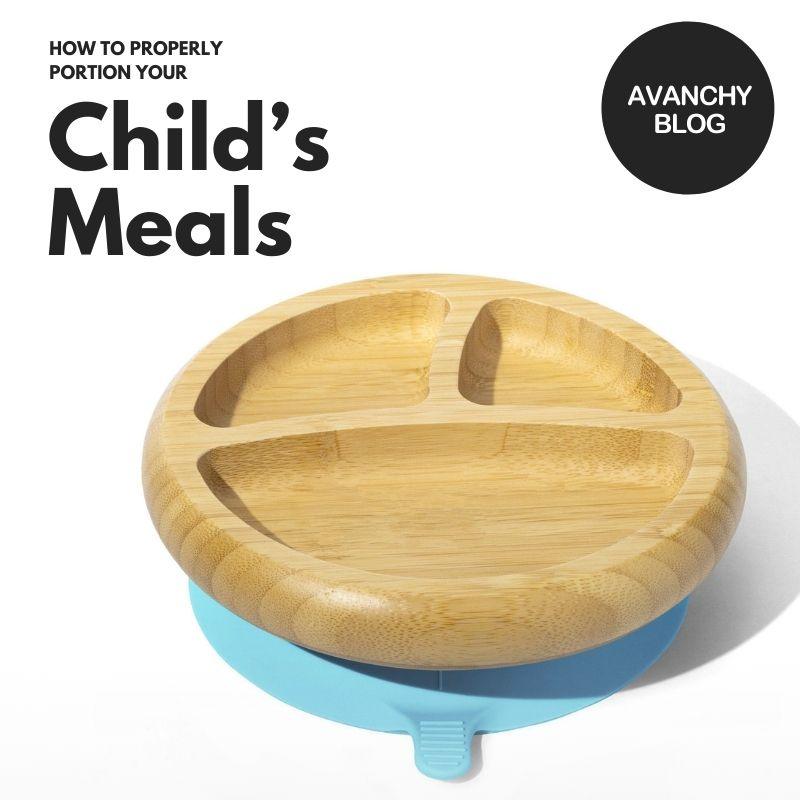Holiday Sale Up to 50% OFF SALE! + 5 pack Bamboo Spoons BOGO!
Holiday Sale Up to 50% OFF SALE! + 5 pack Bamboo Spoons BOGO!
Feeding Essentials

How To Properly Portion Your Child’s Meals
December 28, 2021 5 min read
Overeating is one of the biggest nutrition mistakes adults make. So how can parents better portion family meals and instill healthy eating habits in their children? As always, knowledge is power. Learning proper portion sizes—and why they matter—is the key to helping your entire family experience healthier meals and better eating habits. Discover everything you need to know about portion sizes, including how to properly portion your child’s meals, with our guide to healthy family eating.
The Importance of Portion Sizes
As your little one learns how to feed themselves, they’re developing more than just motor skills. The eating habits your child picks up from you will stay with them for years—possibly for the rest of their life. And serving healthy portions is one of the most important eating habits you can have. As adults, we tend to eat what’s on our plates without thinking much about healthy servings. By emphasizing proper portion sizes early, you can keep family meals healthy and instill good habits that your little one will take with them into adulthood.
Serving Sizes Help
Most foods come with panels of nutrition facts to tell you how many calories, vitamins, minerals, and other components are in the food. These measurements are based around the recommended serving size of the food. One of the biggest mistakes people make when portioning food is eating or drinking an entire product without referencing the serving size. Even smaller containers—such as a small pack of cookies or a bottled beverage—might hold multiple servings. Serving sizes are great references for portion sizes. Following these guidelines allows you to better measure the calories, sugars, vitamins, and minerals your child consumes with each meal.
Of course, serving sizes aren’t the end-all be-all of meal portions. There are times when eating more than a serving size is okay and even healthy. For example, more veggies or fruits can be great sources of vitamins and minerals when your child is still hungry. However, serving sizes are good rules of thumb to prevent overeating or consuming too many unhealthy fats and sugars.
Finding the Right Portions for Your Kids
Kids’ appetites change as they grow, which means their appropriate portion sizes will evolve. Every child has different needs, so touching base with your pediatrician to understand precise portion sizes is always a good idea. Paying attention to your child’s signs of hunger or fullness also helps. For example, babies might turn away from food or get fussy when they’re full. Looking to these cues prevents overeating and teaches your children to listen to and respect their natural appetites.
That said, you can follow general rules for portion sizes throughout the different stages of your child’s development. Use these portions as bases that you can then adjust according to your doctor’s advice and your baby’s needs.
Babies 6–8 Months
All babies venture into the world of solid foods at different times. Your little one might try purees as early as 4 months, or they might wait until closer to 8 months. If you’re not sure when to start, pay attention to your baby’s interest in solid foods—and always consult your pediatrician if you have questions. A good portion size for younger babies is two tablespoons of puree or other liquid-based foods each day. Start small with a teaspoon or two while your baby adjusts to this new world of foods. As your baby grows and learns how to successfully eat their food, you can work your way up to tablespoon portions.
As your baby nears 8 months, you can keep increasing those portions to four tablespoons or a quarter cup. This is also a good time to introduce a second solid meal each day.
Babies 8–12 Months
As your baby grows and gets used to solid foods, you can begin to experiment with more foods and textures. Try dicing or mincing foods instead of just serving purees. Babies also become more active as they learn to crawl, sit up, and even walk from 8 to 12 months. All that activity helps your child work up an appetite, making this the right time to introduce a third solid meal and even some light snacks—such as diced fruits, veggies, or plain cheese—throughout the day.
Toddlers
The life of a toddler is exciting. As your growing child spends each day learning and exploring, they’re going to build up more of an appetite. Toddler meals should include grains, veggies, fruits, protein, and dairy.
Once again, it’s important to consult with your doctor and pay attention to your child’s behavior to determine precisely how much your child should be eating. However, a good rule of thumb is to serve around a quarter cup of most things. A quarter of a cup is a good serving for grains (such as bread or pasta), vegetables, and fruit. You can also serve a quarter cup or a little less of protein, which will look like a couple ounces of meat or two to four tablespoons of beans. Additionally, you can aim a little higher with dairy and serve a quarter to a half cup at each meal.
Tips for Successful Portion Sizes
Knowing proper portion sizes is only the first step to implementing them. Fortunately, you can use a few tricks and tips to introduce better portion sizes. These tips are great for feeding little ones, but you can also use them to help the entire family build better eating habits.
Be Smart About Seconds
Reaching for seconds without thinking about it easily leads to overeating. You can do a few things to be smarter about seconds. First, fill plates away from the table before you sit down to eat. This keeps the big pots and pans out of reach as you eat, taking away the temptation to go in for seconds when you’re not really hungry. Another great tip is to offer vegetables when your child—or anyone in your family—wants seconds. Extra veggies offer plenty of nutrition, making them great ways to fulfill any lingering hunger without overdoing it on calories or sugars.
Use the Right Dishware
The right tools can make any job easier. When you’re learning how to properly portion your child’s meals, the right dishware goes a long way. One simple yet effective trick is to use smaller dishes that make portions seem larger. Smaller dishes prevent eating for the sake of eating, making it easier for you to stop whenever you feel full.
Another great tip when you’re serving little ones is to use sectioned plates. The sections on each plate help you monitor how much you’re putting in front of your baby. Avanchy sells durable, high-quality suction cup baby plates with portioned sections to make mealtime as healthy as it is convenient. With our safe and sustainable dishware on the table, you can teach great eating habits that will promote your child’s health for years to come.

Subscribe
Sign up to get the latest on sales, new releases and more …










